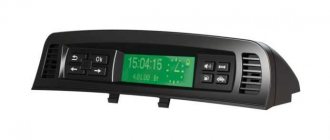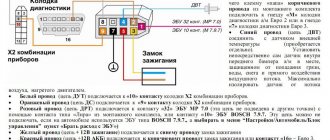In this article, we will figure out how to reset your computer to factory settings in Windows 10, in other words, how to return the system to its original state. Despite the fact that this procedure cannot be called ordinary, sometimes the need for it arises, so we will try to cover this issue in detail.
The advantage of Windows 10 is that you don’t need any boot disks, flash drives, etc. to restore the system to factory settings.
Note: we draw your attention to the fact that you need to resort to returning the system to its original state only in cases where there are no other options left to solve the problem that has arisen with the OS. A number of problems that may arise during the process of resetting the “tens” are described at the end of this article.
Purpose of factory reset
See also: “Compatibility mode in Windows 10: how to enable, disable”
First, let's understand what the purpose of resetting the system to factory settings is. This procedure is performed when the OS is malfunctioning (errors) and it is not possible to return it to normal operation.
Thanks to this feature, there is no need to reinstall the system. At the same time, there is an undeniable advantage - the user’s personal data (files, documents, photos, videos, music, etc.) will not go anywhere when returning to factory settings.
Method 2: Restore Point
The second method involves using a system restore point. In this case, only system settings will be changed, and downloaded files and programs will remain intact. But the main problem is that if you want to reset the settings exactly to factory settings, then in order to do this, you need to create a restore point as soon as you purchased the laptop or installed the OS on the PC. But not all users do this.
- So, if you have a restore point created before you started using your computer, then go to the Start menu. Select "All Programs".
- Next, go to the “Standard” directory.
- Go to the "Service" folder.
- In the directory that appears, look for the “System Restore” position and click on it.
- The selected system utility is launched. The OS recovery window opens. Here just click “Next”.
- Then a list of restore points opens. Be sure to check the box next to “Show other restore points.” If there is more than one option, and you do not know which one to choose, although you are firmly convinced that you created the point with factory settings, then in this case, select the earliest date point. Its value is displayed in the “Date and Time” column. Having selected the appropriate item, click “Next”.
- In the next window, all you have to do is confirm that you want to roll back the OS to the selected recovery point. If you are confident in your actions, then click “Done”.
- After this, the system reboots. It will probably happen several times. After completing the procedure, you will receive a functioning OS on your computer with factory settings.
As you can see, there are two options to reset the operating system to factory settings: by reinstalling the OS and returning the settings to a previously created restore point. In the first case, all installed programs will be removed, and in the second, only system parameters will be changed. Which method to use depends on a number of reasons. For example, if you did not create a restore point immediately after installing the OS, then you only have the option that was described in the first method of this guide. In addition, if you want to clean your computer from viruses, then only this method will do. If the user does not want to reinstall all the programs that are on the PC, then you need to use the second method.
We are glad that we were able to help you solve the problem. In addition to this article, there are 12,717 more instructions on the site. Add the Lumpics.ru website to your bookmarks (CTRL+D) and we will definitely be useful to you. Thank the author and share the article on social networks.
Describe what didn't work for you. Our specialists will try to answer as quickly as possible.
Reset from a running system
This method works in cases where you can log into the system. Here's what we do:
- Go to Windows Settings. To do this, right-click on the Start menu icon (or press the Win+X keys) and select the appropriate item in the context menu. You can also simply press the Win+I key combination.
- In the settings that open, go to the “Update and Security” section.
- In the side menu on the left, click on the “Recovery” subsection. On the right side of the window we find a block called “Return the computer to its original state”, in which we click the “Start” button.
Note: In some cases, the system may inform us that it cannot find the files needed to complete the recovery procedure. Then we move on to the second section of our article. - In the window that opens, click on one of two options depending on your goals:
- Saving personal data. Only programs and system settings will be removed.
- Complete removal of all data on the computer. This option is suitable in cases where you decide to sell or transfer the computer to another user. In this case, you will be prompted to format (clean) the disk.
- If we have chosen to save the data, the next window will present a list of applications that will be deleted. Click the “Next” button.
- If you choose to delete data, the next step will prompt you to quickly wipe or format the disk, which may take some time.
- In the final window, we click the “Factory Reset” button, after which the reset process will begin, after which the computer (after several reboots) will start in its original form.
Note: if you chose the option of saving personal data, the “Windows.old” folder will appear on the system’s hard drive, in which duplicates of all the old “ten” files will be recorded (documents on the desktop, files in the “My Documents” folder, etc.) d.). If you don't need this folder, you can delete it. How to do this, read our article - “How to delete the Windows.old folder in Windows 10“.
Resetting the Administrator Password Using Manufacturer Recovery Files
Some PC and laptop manufacturers include a special disk with a recovery partition that allows you to restore your Windows 10 installation to factory defaults. This can usually be activated by restarting your computer and pressing a specific key on your keyboard during the boot process.
The key you press will vary depending on the device manufacturer. For example, some HP computers require you to press and hold the F11 key on your keyboard while the computer boots.
Each manufacturer has their own on-screen instructions on how to activate and start this process. Consult your PC or laptop's user manual for any special instructions on how to use the recovery partition on your PC, as well as which key to press.
If your computer does not have a recovery partition available, you will need to use one of the methods listed above to restore Windows 10 to factory settings.
Using the New Start feature
See also: “Local account in Windows 10: how to create, delete”
This function (formerly called Refresh Windows Tool), available in the latest versions of Ten, allows you to return the OS to its original settings. In this case, the user's personal data will be saved.
- Go to recovery options. How to do this is described in the first section of the article.
- On the right side of the window, find the inscription “Find out how to start over with a clean installation of Windows” and click on it.
- The system will ask you for confirmation to switch the application. Click the “Yes” button.
- Windows Defender Security Center will open. On the right side of the window, in the “New Start” section, click the “Get Started” button.
- A new system startup window will open. Having familiarized yourself with what exactly will be done, click the “Next” button (if you agree).
- The system will be returned to its original state.
Once the system recovery is complete, it is recommended that you clean up your system files.
- Launch the “Run” window by pressing the Win+R keys. We write the command “cleanmgr” and click OK (or press the Enter key).
- The Disk Cleanup utility will open. Click the “Clean up system files” button.
- After evaluating the disk (which may take several minutes), a window will open in which we can select unnecessary data that can be deleted, as a result of which, free up excess space.
Why do you need to restart your Windows 10 PC?
You've done all the possible troubleshooting steps, but there are still problems with your Windows 10 PC. Is it good to restart your computer in Windows 10? If you have no other ideas on how to get it to behave and fix the issues that are bothering you, then yes, resetting Windows 10 could be the answer.
Does rebooting my PC speed up? Another reason is the performance of your Windows 10 device. If Windows 10 is moving slower than when you started using it, there may be too many apps or services running in the background, some faulty drivers, etc. Sometimes the only way to get things in order is this is to reset the settings.
So, what happens if you choose Reset this PC in Windows 10? Before you continue, there are a few questions you should know the answers to:
- Does Windows 10 Reset this PC remove drivers? Yes : Resetting your Windows 10 PC means all system files and drivers will be removed and then restored to their original values.
- Does resetting your computer erase all drives? The answer is no , not by default. However, during the reset process you can also delete everything from all your drives if you wish.
- Will I lose my apps when I reset Windows 10? Unfortunately, all of your desktop apps will be removed from your PC, so you'll have to reinstall and reconfigure each one after the reset process is complete.
- Does resetting this computer delete my personal files? You can save your personal files, you won't lose them in the process. What are personal files in Windows 10? These are files stored in your user folders: Desktop, Downloads, Documents, Pictures, Music and Videos. Files stored on disk partitions other than the “C:” drive also remain intact. However, documents stored in applications are lost.
- Will restarting my PC remove viruses? It depends. This usually happens if the viruses on your computer are not very dangerous. But if we're talking about specific types of malware like rootkits, resetting won't help unless you also decide to lose your personal files and wipe all drives. Otherwise, viruses may also be on your other drives, partitions, or even your OneDrive cloud space, and as soon as Windows 10 is rebooted, they will infect it again, probably almost instantly. Regarding bloatware, we recommend doing a clean install of Windows 10 rather than just doing a reset.
If you agree with all of the above, there are two ways to initiate a Windows 10 reset. The first method is using the Settings app. The second method starts the reset process from the login screen. This second method may be useful if you are having trouble logging into Windows.
If your Windows 10 installation is severely damaged and you can't even get to the login screen, you may want to consider a few other options:
- Boot into Safe Mode. Read how to start Windows 10 in safe mode.
- Troubleshoot Windows 10 using recovery media.
Reset the system if it won't start
Now let's figure out what to do if you can't start the operating system. In this case, motherboard tools or installation disks (flash drives) will help us.
In fact, most laptops with licensed software have a special keyboard shortcut that allows you to return them to factory settings. This method can also work for stationary PCs with a pre-installed system.
In other cases, we launch the recovery mode from the boot disk/flash drive (most likely, you will need to change the device boot priority in the BIOS menu settings, putting the disk or flash drive in first place).
Note : if the operating system starts, you can get to the recovery menu from the recovery options by clicking the “Restart now” button in the special boot options (Options - Update and Security - Recovery).
You can also get to the recovery menu from the lock window. To do this, click on the “Shutdown” button, then hold down the Shift key on the keyboard and click “Restart”.
So, here's what you need to do once you're in the recovery menu:
- Click on the “Troubleshooting” item.
- In the next window, select “Restore the computer to its original state.”
- Next, two options will be offered. Click on the one you need:
- save user data
- delete all data
- Select an account.
- Enter the password for the selected account (don’t forget about the keyboard layout) and click the “Continue” button.
- Everything is ready to return the computer to its original state. All that remains is to press the appropriate button.
Note: After restoring the system, you should return all BIOS menu settings to their original values (if any changes were made).
How to reset Windows 7 settings
You can reset your computer to factory settings on the seven. Everything works the same way: a full reset returns the system to its original state, all files and applications are deleted. Therefore, do not forget about backups and saving important data.
How to reset the system on Windows 7:
- Go to the Start menu.
- Open the “Control Panel”.
- In the “System and Security” section, select “Backup computer data.”
- Select “Restore system settings or computer.”
- Next, “Advanced recovery methods.”
- Here we need the second option: “Return the computer to the state specified by the manufacturer.”
- We will not describe the subsequent steps, since there you just need to follow the recommendations and click the “Continue” button. Next, a reboot will occur and the system will reset, and at the end of the process you will receive a device with clean Windows 7.
Resetting Windows to factory settings is a convenient tool that eliminates the hassle of creating images on flash drives and reinstalling the OS. In addition, it does not require any knowledge and everything is done in just a couple of clicks.
Topic: 10 cool gestures on a laptop touchpad that will make working with Windows easier
Possible problems with returning Windows 10 to factory state
In some cases, users may encounter the information message “There are problems resetting the computer to its original state. No changes were made." This error indicates that there are certain problems with the files (damaged, deleted or changed) for recovery that are located in the WinSxS folder.
If this happens, but the system continues to function, you should check the system files and sectors of the hard drive for integrity. If this cannot be done, or this measure did not help, you will most likely have to do a clean installation of the system. At the same time, it would be a good idea to make a backup copy of your personal data (for example, on a USB drive or external hard drive).
In some situations, the system may require a boot disk or flash drive. In this case, the action algorithms described in the second and third sections of the article can help.
Also, if you don’t have a boot disk or flash drive at hand, you can register your own system image to restore it. In this case, it is important that the OS functions properly. We do the following:
- Download the disk image with the system.
- Now you need to mount it using a drive emulation tool and copy the file called “install.wim” (located in the “sources” folder) to the “ResetRecoveryImage” directory, which can be created on any computer drive except the system one. Instead of emulators, you can use archivers.
- Open a command prompt with administrator rights. This can be done in the Start context menu, which is launched by pressing the Win+X keys.
- Enter the command reagentc /setosimage /path “D:\ResetRecoveryImage” /index 1 and press the Enter key. In this command, the path (after the path phrase, in quotes) leads to the folder we created in step 2.
- Thanks to the steps taken, we created and registered a system recovery image.
- After the procedure is successfully completed, you can try resetting the system.
Note: You can make your own system backup, which may be useful in the future if any problems arise.
Using Windows installation media to reset or reinstall Windows
The easiest way to factory reset your Windows 10 PC without an administrator password is to use the method above. However, if your computer is having problems, you can completely erase your hard drive by using Windows installation media to reinstall or reset Windows.
You can from the Microsoft website. It can be burned to a new DVD or burned to a USB drive. If you have a second Windows 10 computer, you can flash this ISO file onto a USB drive using the Rufus flashing tool.
Linux users can do this with WoeUSB, and MacOS users can use the official Boot Camp Assistant app, which comes installed on all Mac devices.
- If you have a Windows 10 ISO file and the Rufus tool downloaded, open Rufus on a second Windows PC. Make sure your USB drive is selected from the drop-down menu, then click the Select to select the ISO file.
- Select the Windows 10 installation ISO file from the file selection menu, then click Open .
- Rufus will automatically change its settings to match the requirements for flashing a bootable Windows USB drive. Once you're happy with the settings, click the Start to flash the drive. This will erase it, so be sure to back up any important files stored on it before you start.
- It will take some time. After Rufus finishes flashing the USB drive, reboot your computer to load the Windows installation screen. On the Windows installation screen, you will need to select the language that will be used during the installation process.
- You also need to select the language for your time and currency, as well as the keyboard language you will use. When you're ready to continue, click Next .
- Click the Install Now to begin the installation process.
- At this point, the Windows installation files will download. At this point, you may need to provide your Windows 10 product key to activate the installation, so enter that key here. If you don't have a key, enter the I don't have a product key . If you choose this option, you will need to activate Windows after the installation is complete.
- If the option is available, select the version of Windows 10 you want to install, then click Next .
- You will then need to accept the Windows 10 License Agreement. Check the I accept the license terms , then click Next to continue.
- The installer will detect an existing Windows installation. To bypass the administrator password, it is better to select the Custom option here: Install Windows only (Advanced) . This will erase all files from your PC before reinstalling Windows.
- In the next step, select the drive to install Windows. If you have multiple partitions, you may need to delete and recreate them first. To continue, click Next .
At this point, Windows will begin wiping your disk and copying files for a new installation. Windows will then restart to begin the next step of the installation process, allowing you to create a new user account once the process is complete so you can use the computer again.
How to reset Windows 10 and keep personal files (using Windows Recovery Environment)
You can also reset Windows 11 from the Windows Recovery Environment even before you go to your desktop. On the Windows 11 login screen, press and hold the Shift key while selecting the power icon, and then click Restart in the bottom right corner of the screen.
After your computer restarts, select Troubleshoot.
On the next screen, select Reset this PC.
Since you want to keep your personal files, select the "Keep my files (removes apps and settings, but keeps your personal files)" option.
Since you are not signed in, you will need to authenticate with Windows 10 before continuing with the reset process. Windows 10 displays a list of users defined on your system. Select your user and log in.
Your computer will then ask you if you want to reinstall Windows 10 using a cloud download or a local reinstall method. Select the one you like best by clicking or tapping on it.
Windows then takes a little time to prepare everything. When it's done, your Windows 10 PC will notify you. If you're still sure you want to reset it, click or tap the Reset button. However, please note that this is the last moment when you can change your mind and cancel the reset.
Wait a few minutes until your Windows 10 computer restarts. Depending on the power of your computer's hardware, this step may take some time.
After some time, Windows 10 begins to reinstall.
Once the installation is complete, you can log in with your account.
Result
So, what do we get after a factory reset? Let's take a closer look. The first thing I noticed was that the “login without password” configured in the old Windows 10 remained working. The desktop shortcuts and all user data remained in place, and the color scheme and wallpaper remained. But what immediately catches your eye is that the system has again installed all the garbage on the “Taskbar” that was disabled in the previous installation.
All pinned tiles in the Start Menu have disappeared, and the menu itself is now filled with folders of non-existent programs and games.
All previously installed drivers were removed and Windows 10 installed the old driver version 456.71, released back in October 2022, on the GeForce GT 1030.
The Windows 10 build number has not changed, but the installation date is now more recent.
All programs are removed, but OneDrive is installed.
A list of all remote programs is on the “Desktop” in an html file and allows you to download some of them from the developer’s website using a link.
Continuing to explore the system, I discovered that Windows 10 retained most of the user settings. Images still open through the old Windows Photo Viewer. The paging file settings, disabling hibernation and network settings remained in place.
Privacy settings and other settings are in the same position as before the reset.
There are even pinned folders left in Explorer's Quick Access Toolbar.
And even Microsoft Defender settings and file and folder exclusions remained untouched.
Now about the main thing. What happened to the bugs? The bugs have disappeared and this is good news - the screen saver has retained its settings and now launches correctly. The bug with flickering program windows and parasitic activity has disappeared, and the system feels like new and working smartly.
How to remove the application list during the reset process
When you start the reset process from the Settings app, Windows 10 allows you to see a list of apps that will be removed before starting the reset. If you don't save the list beforehand or start the reset from the login screen, you will still be able to find the list after the process is complete. It is saved on your desktop as an HTML file called "Deleted Applications".
Opening the HTML file gives you a list of applications that were removed when you restarted your computer. Now you can decide which ones you need and reinstall them one by one.
Applications removed when computer restarts
That's all!











